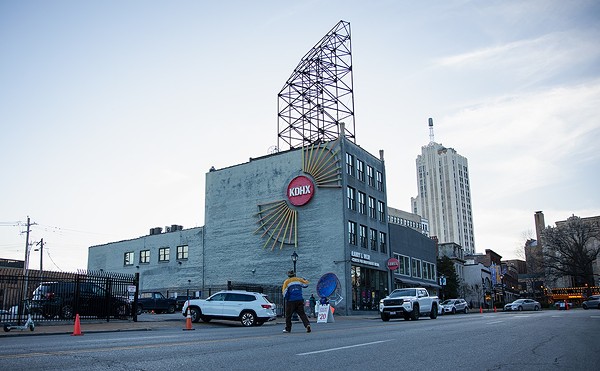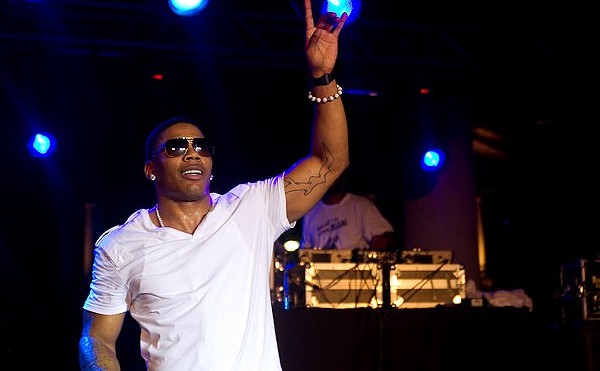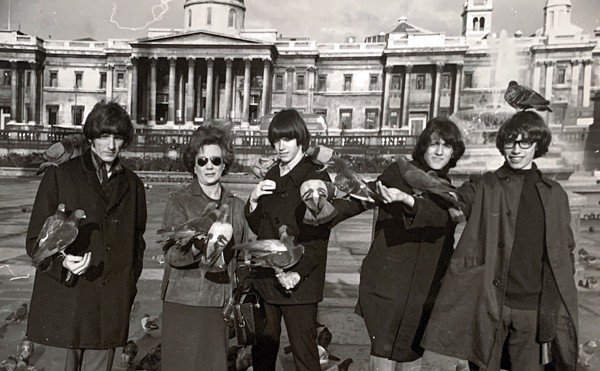Good thing, that. He played guitar instead. Plugging into an old tube amp in the corner of my apartment, he knocks out a lick from Gram Parsons' "Las Vegas," that rolling, bending seventh-chord spangle, that sounds like the blinding, bright gears of a chrome engine accelerating free. He holds the pick between his thumb and bent index finger, James Burton-style, leaving his other fingers free to attack. He plays licks he's ripped off from Junior Brown and Jimmy Page. His left hand seems to span 10 frets, seems to bend all the strings at once, and now the sound is like a chrome engine weeping. "I play all these stolen, lifted riffs. Some I make up. I was always a sucker for that intro to Merle Haggard's 'Mama Tried,' and you can adapt that to other stuff." He echoes those rolling notes but puts his own English on them, and now the lick is truly his.
John Horton's Telecaster has become the sound of some of St. Louis' best roots-based bands: the New Patrons, the Rockhouse Ramblers, Kamikaze Cowboy. He's grown from a kid in love with Led Zeppelin into a man who possesses some of that "mathematical" genius, as Bob Dylan once said of his Tele player, Robbie Robertson. "There were two shifts. I finally got a decent electric guitar, a Les Paul. Jay Farrar owns it now. I wish I hadn't got rid of it. Then, when I was 20, I took a music theory course at East Central Junior College. That really opened a lot of possibilities. I found the mathematical, cyclical things that apply to any song, all of Western music, blues, jazz, rock & roll, Brahms, Schoenberg. It all works, if you know where you're going."
In the early '90s Horton met up with Bob Reuter and Kamikaze Cowboy. "I kicked him out of the band," Reuter says. "He didn't have any kind of discipline. I liked his stuff, but he'd never play anything the same way. The band would play, and he'd play over the top of it." Time passed, and Horton has learned to play with more economy, to make fewer notes count for more. He's simply more in tune with the songs. "Knowing where the vocals are is very important to me," he says. "I really try to pay attention to that, although some might say otherwise."
"When I first knew him he was this kid with long, straight hair past his shoulders," Reuter says. "I've seen him create this character. He looks like some hillbilly cat from the '60s. He doesn't just wear blue jeans; he wears new blue jeans. He's got a cigarette dangling from his mouth like some guy out of Webb Pierce's band. He's so into the music that he's just become this person. He keeps searching for more authenticity, and he soaks it up and it all becomes who he is."
Who John Horton is is a ferociously dedicated musician, shy in conversation but not shy about his ambition. He's leaving St. Louis, heading for Nashville in the new year: "It's real hard to leave. I had so many hopes for the New Patrons. But that's all right. That was the most fun I ever had playing, the most musically satisfying. And I've learned. But I've done as much here as I can do. There doesn't seem anywhere else to go, in St. Louis. I'd like to be around the music industry. I've gotta see what I'm made of. If I don't, I don't know what else I'd do."
-- Roy Kasten





